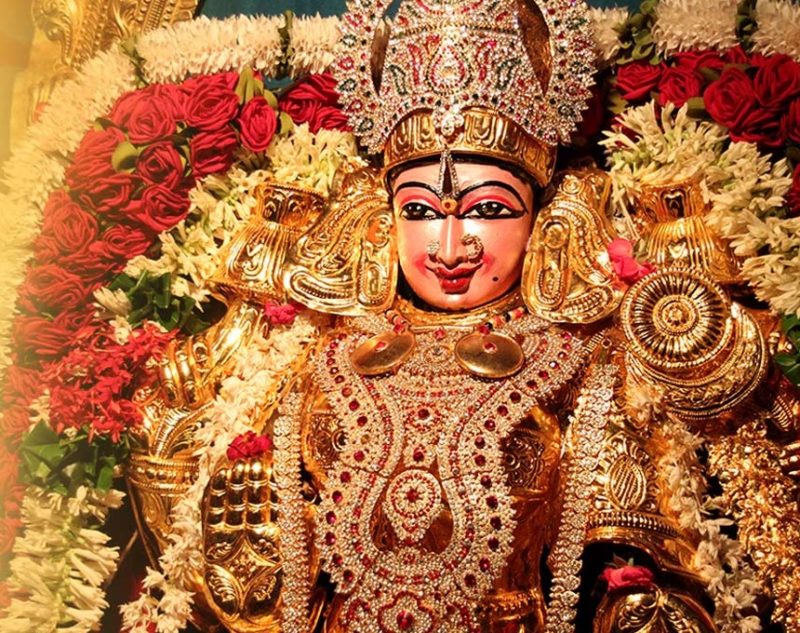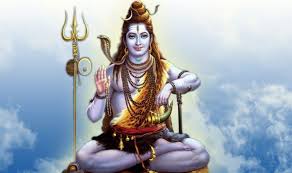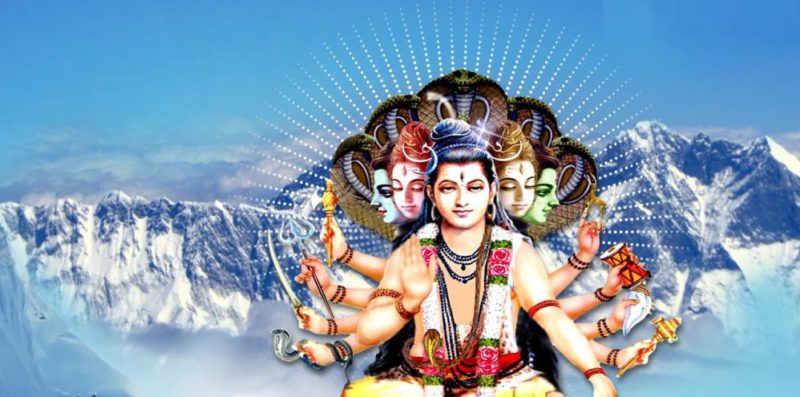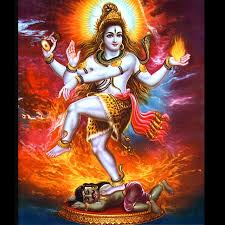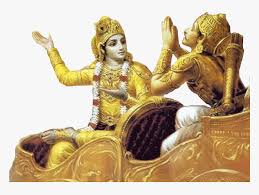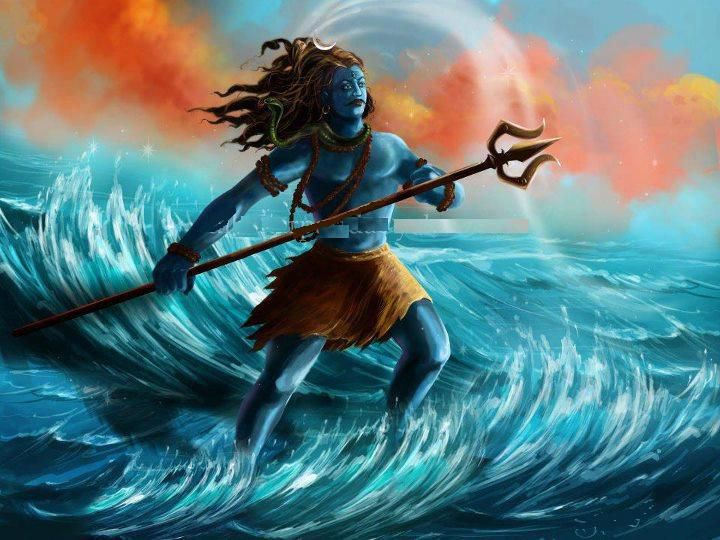No products in the cart.
(Composed and scripted by V.D.N.Rao)
Origin and Realization of Manidweepa
Maha Devi Herself explains that Maha Purusha and Herself was just the same as a lamp and reflection in a mirror and that She was neither a female nor a male, but a Unique Genderless Nirguna. Any changes witnessed are due to the interplay of ‘Antah Karanas’ or natural instincts like Mind, Buddhi, ( Mental Power) and ‘Ahankara’ ( Ego) on the one hand and ‘Maya’( Illusion) on the other. At the time of Creation following the Great Dissolution (Pralaya), the dissimilarities occurred as Gender, ‘Karma’ ( Fate) and ‘Anthah Karanas’ all created by ‘Maya’. It was at that time of Creation, that The Supreme Energy assumed various ‘Vibhutis’ or Manifestations like Sri (Prosperity), Buddhi(Brainpower), Daya (Com -passion), Dhriti (Tolerance), Smriti (Memory), Shraddha (Conviction), Medha ( Acumen), Lajja (Shyness), Shanti ( Peace), Nidra ( Sleep), Pipasa ( Desire), Vidya ( Comprehension), Spriha ( Awaken -ness or Alertness) and Shakti ( Power). Maha Devi continued to state that She was the Para, Madhyama and Pasyanti ( Mystic expressions of the Supreme Power indicating the Stages of Manifestations of the Eternal Force); She was Para Shakti beyond one’s Comprehension, Madhyama Shakti who was both Expressed and Unexpressed ( Vyakta –Avyakta) and Pashyanti Shakti who was Fully Manifested and recognisable with Physical Form or Saakara Shakti; She was also present in thirty five million ‘Nadis’ through out a human body (the tubular organs of the body like arteries, vie ns, intestines, blood vessels, pulses etc. She was in Vasa (fat), majja ( marrow), Tvak (skin) and Drishti ( eye sight) clearly present in each and every part of ‘Samsara’. So was the case of non moving objects of Creation either animate or inanimate. Maha Devi further affirmed that She was seen as Brahmi or Sarasvati, Vaishnavi or Lakshmi, Eswari as Gauri, Indrani as Indra, Varuni as Varuna, and so on whose formations were all Hers, making the counterpart Purushas perform their tasks as the Maha Devi’s agents or instruments of action. She was the Gunas of Satva, Rajas and Tamas; Ahamkaras-Jnana Sakti ( the Power of Knowledge), Kriya Sakti ( The Power of Action) and Artha Sakti ( The Power of Wealth or Maya the Illusion); The various Tatvas and Maha Tatva; and the interplay of Five Tanmatras or Subtle Elements viz. ( Touch, See, Breathe, Hear and Taste) and Five Basic Elements ( Earth, Air, Water, Fire and Sky) known as the Process of ‘Panchee- Karana’ resulting in Five Causes. This was made into a Jeeva ( Living Entity) and the Cosmic Totality of That would be Brahma, stated Devi Bhagavati! The features of the Three ‘Gunas’ or attributes were explained to Narada. Normally, Faith is known to exist in the form of three Gunas viz. Sattva Guna, Rajas Guna and Tamas Guna. Sattva is described as the fountain of Goodness and happiness in a pure form. Its colour is stated to be white standing for purity, integrity, happiness, contentment, forgiveness and faith. The Rajas Guna is stated to be red in colour and is featured as false pride, deceipt, avarice, hatred and selfishness. The Tamo Guna standing for black colour is stated to feature ignorance, lack of resources, anger, fear and quarrelsomeness. There is no set identity of the Gunas but are intermingled and rapidly changeable. A person who is Good basically might spurt out into anger and pride and change over in the same breath to fear. But surely the resultant impact would be disaastrous; An unfullfilled desire would lead to anger. Anger leads to obsession. Obsession leads to failure of memory ( focussed thinking) and lack of memory leads to mental balance!
Manidweepa the Abode of Devi Bhagavati
Being far superior to Kailasa, Vaikuntha and Goloka, the Sarvaloka or Manidweepa is the residence of Devi Bhagavati in whom the entire Creation rests! Indeed She resides everywhere and anywhere but notionally at Manidweepa and the description is transcripted in detail by Maharshi Veda Vyasa apparenly for the consumption of mortals to carry conviction into their consciousness. Surrounded by ‘Sudha Sagara’ ( The Ocean of Nectar), Manidweepa has a strong iron enclosure of several Yojanas far and wide with four gates well guarded by Devas and Devis.
Within the First Enclosure, there is an Enlosure of white metal made of an amalgam of zinc and tin/copper which touches Heavens and is hundred times higher than the walls of the outer Enclosure.This Enclosure is interspersed with gardens and forests with a wide range of trees and plants, flowers with intoxicating fragrances, luscious fruits along with streams of fruit juices and gregarious animals and birds of staggering variety.
The third Enclosure is made of copper with a height of seven yojanas comprising several ‘Kalpavrikshas’, with golden leaves/ flowers and fruits yielding gems, fulfilling desires of any imagination.The King of the Gardens along with the wives Madhu Sri and Madhava Sri maintains an excellent Spring Season, where Gandharvas reside, rendering divinely songs and music.
The Fourth Enclosure made of lead with its wall height is again seven yojanas and within the Enclosure are the Sanatanaka trees with flowers whose fragrance reaches as far as ten yojanas and fresh fruits providing sweet juices of great quality and its King with the two queens Sukra Sri and Sudha Sri always maintains enjoyble mild summer where Siddhas and Devas reside here.
The Fifth Enclosure made of brass with a spread of ten yojanas is maintained by its Chief as a perennial Rainy Season accompanied by twelve of his wives,viz. Nabha Sri, Nabhyasya Sri, Sravasya, Rasyasalini, Amba, Dula, Niranti, Varidhara, Abhramanti, Megha Yantika, Varshayanti, and Chivunika. The Trees grown in the Gardens of this Enclosure are Hari Chandana.
The Sixth Enclosure is made of walls with five-fold irons and its Gardens grow Mandara Trees and creepers; the wives of its Chief are Isalakshmi and Urjalakshmi maintaining the Season of Autumn. Here again Siddhas reside with their wives.
The Seventh Enclosure of seven Yojanas of length is made of Silver, its Chief maintaining Hemanta (dewy) Season with his two wives Saha Sri and Sahasya Sri with Parijata as its main tree and flowers.
The Eighth Enclosure is made of molten gold with Kadamba garden in the center with Tapas Sri and Tapasya Sri as the wives of the King and the fruits of the trees yield honey that is consumed aplenty by Siddhas and wives who are the inhabitants and the season again is dewy.
The ‘Navavarana’ or the Ninth Enclosure is made of Pushparaga gems of Kumkum (saffron) colour which is abundant all over inside the Enclosure like forests, trees, rivers, flowers, lotuses, ‘Mandapas’ (Halls), pillars and so on. All the ‘Dikpalakas’ of High Regency reside in the Eight Directions of the Enclosure, with the thousand eye bodied Indra in the East in Amaravati on Airavata with Sachi Devi, ‘Vajra Ayudha’ or thunderbolt, the Celestial Apsarasas and the rest; Agni Deva in South East with his two wives Svaha and Svadha , his Vahana and other belongings; Yama Dharmaraja in the South with his ‘Yama danda’ ( his Symbol the Celestial Rod) along with Chitragupta; Nirruti in the South West with his axe and wife representing Rakshasas’; Varuna Deva in the West with his wife Varuni and ‘Pasa’ ( the noose), drinking Varuni honey and with the King of Fishes as his Vahana (Vehicle) and surrounded by aquatic animals; Vayu Deva in the North West with his wife, forty nine members of his Vayu family along with groups of Yogis adept in Pranayama and other practices along with his Deer Vahana; the King of Yakshas and Unparallelled Possessor of Gems and Jewels Kubera in the North along with his two Shaktis Viriddhi and Riddhi and his Generals Manibhadra, Purnabhadra, Maniman, Manikandhara, Manisvargi, Manibhushana and Manikar Muktadhari; Rudra Deva in the North East with other Rudras who are angry and red eyed, armed and mighty, frightful and revolting, fiery mouthed and detestably distorted, some times ten handed or thousand handed, odd number footed and odd number mouthed; in the company of Bhadrakalis and Matriganas, Rudranis and Pramadhaganas making ‘Attahasas’ or reverberating screeches and so on.
Tenth Enclosure made of Padmaraga Mani inside which are the Sixty four ‘Kalas’ like Pingalakshi, Visalakshi, Vriddhi, Samriddhi, Svaha, Svadha and so on each of these having hundreds of akshouhini strong armies and individually each of these ‘Kalas’ have the unimaginable Power of destroying a lakh of ‘Brahmandas’(Universes)!
The Eleventh Enclosure is made of Gomeda Mani and within this are the sin-destroying and beneficent Maha Shaktis viz. Vidya, Hri, Pushti, Prajna, Sinivali, Kuhu, Rudra, Virya, Prabha, Nanda, Poshani, Riddhida, Subha, Kalaratri, Maharatri, Bhadra Kali, Kapardini, Vikriti, Dandi, Mundini, Sendhu Kanda, Sikhandini, Nisumbha Sumbha Madini, Mahishasura Mardini, Rudrani, Sankarardha Saririni, Nari, Nirayani, Trisulini, Palini, Ambika and Hladini.
The Twelfth Enclosure made of Diamonds and is the dwelling place of Bhuvaneswari, and is surrounded by Eight Shakties viz. Anangarupa, Ananaga Madana, Madanantara, Bhuvana Vega, Bhuvana Palika, Sarvasisira, Ananga Vedana and Ananda Madana; each of these Main Atteandants of Bhuvaneswari has a lakh of Attendants.
The Thirteenth Enclosure is made of Vaiduryas and the Residences of Eight Matrikas viz. Brahmi, Mahesvari, Kaumari, Vaishnavi, Varahi, Indrani, Chamunda and Mahalakshmi.
The Fourteenth Enclosure made of Indranilamani, which is the Most Auspicious Place of the Sixteen Petalled Holy Lotus with Sixteen Maha Shaktis resident viz. Karali, Vikarali, Uma, Sarasvati, Sri, Durga, Ushas, Lakshmi, Sruti, Smriti, Dhriti, Sraddha, Medha, Mati, Kanti and Arya.
The Fifteenth Enclosure made of ‘Mukta’ or Pearls inside which reside Eight Shaktis Ananga Kusuma, Ananga Kusuma Tura, Ananga Madana, Ananga Madanatura, Bhuvanapala, Ganganavega, Sasirekha, and Gangana Vegarekha.
The Sixteenth Enclosure which is made of Marakatha (Vaidurya) is hexagonal of Yantra Shape, and on the eastern corner of the Center is the Brahma with Devi Gayatri with Vedas, Sastras and Puranas as well as their Expansions; on the Western corner is Maha Vishnu and Savitri along with ther own Expansions; on the North Western corner is Maha Rudra and Sarasvati with Rudra and Parvati Expansions and Sixty four Agamas and all Tantras; on the South Eastern side is the abodes of Kubera and Maha Lakshmi; on the Western corner side are the Couple of Madana and Rati Devi and on the North Eastern side are Ganesha and Pushti Devi.
The Seventeenth one is made of Prabala (Red like Saffron) Devi Bhagavati’s five Elements viz. Hrillekha, Gagana, Raktha, Karailika, and Mahochuchusma;
Finally, the Eighteenth Enclosure is built with Navaratnas ( Nine Jewels) with Bhagavati in the Center with ‘Pancha Amnayas’ (Eastern Amnaya is Creation by Mantra Yoga, Southern is Maintenance by Bhakti, Western is Pralay by Karma Yoga, Northern is Grace by Jnana Yoga and Urdhva Amnaya is Liberation); ten Maha Vidyas (Kali,Tara, Chhinnamasta, Bhuvaneswari, Bagala, Dhumavati, Matangi, Shodasi and Bhairavi) and Avataras viz. Bhuvanesvaris Pasamkusavari, Bhairavi, Kapala, Amkusa, Paramada, Sri Krodha , Triptavasarudha, Nityaklinna, Annapurnesvari and Tvarita .
Ratnagriha or the Crown Palace of Mula Prakriti or Maha Devi Bhagavati is beyond the Eighteenth Enclosure, built of Chintamani Gems with thousands of pillars built by Suryamani Gems or Vidyutkantamani Gems. Four huge ‘Mandapas’ or halls each with thousand pillars in the Palace are made of kaleidoscopic and artistic mix of ‘Navaratnas’ ( The Nine Gems) viz. Mukta, Manikya, Vaidurya, Gomeda, Vajra, Vidruma, Padmaraga, Nila and Marakatas with dazzling lights and exhilarating perfumes suited to the Themes of the Halls designated as Shringara, Mukti, Jnana and Ekanta.
In the Central place of each of the Halls, there is a Very Special Chintamani Griha or the Sanctum Sanctorum on a raised platform with a plank supported by the four legs of Brahma, Vishnu, Rudra and Mahesvara and the plank is Sadasiva Himself!
The Maha Tatvas are the stair cases leading to the Upper Chambers. Mula Prakriti and Maha Purusha constitute two halves of the Physical Formation of Maha Devi cum Maha Deva with Five Faces of Each Half, with corresponding three Eyes and four arms and armoury , one hand reserved exclusively for providing boons. The Attending Sakhies are those surrounding the ‘Ardhanarisara’ are Icchaa Sakti, Jnaana Sakti and Kriya Sakti who are always present with the Maha Bhagavati along with Lajja, Tushti, Pushti, Kirti, Kanti, Kshama, Daya, Buddhi, Medha, Smriti and Lakshmi in their physical Forms. The Nine Pitha Shaktis Jaya, Vijaya, Ajita, Aparajita, Nitya, Vilasini, Dogdhri, Aghora and Mangala are at the constant Service. Devi Bhagavati is simultaneously present in all the Mandapas; enjoying Vedas, Hymns of Praise, and Music in Shringara Hall; freeing Jivas from bondages in Mukti Hall; rendering advice and instructions in Jnana Hall and conducting consultations in Ekanta Mandapa with Ministers like Ananga Kusuma etc.on matters of vital significance related to Creation, Preservation and Destruction of Evil.Indeed the inhabitants of Manidweepa are all those who have attained Samipya, Salokya, Sarupya and Sarvasti. They have no Arishdvargas to overcome, no tatvas to gain, no gunas to regulate, no Yogas to perform, no ambitions or desires to fulfil. They have no concepts of time, death, age, distance, body, mind, light, season or the ‘Tapatriyas’. Human beings normally tend to describe the negativity of life always but the Eternal State of Perfect Equilibrium is some thing utterly unimaginable!
Maharshi Veda Vyas assured that reading, listening or imagining about Manidweepa and of the Glories of Devi Bhagavati would provide peace of mind, contentment and fresh springs of hope, purpose and direction of life especially when new projects or actions are launched as also when apprehensions, obstacles, diseases, tragedies or even death are envisaged! ( Source : Devi Bhagavata)


